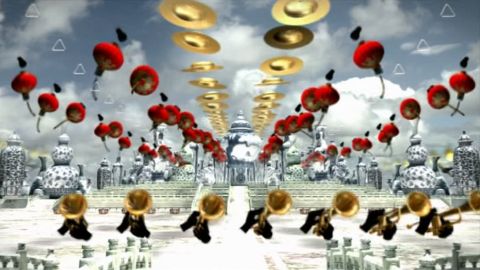|
<< -- 2 -- Robert Anderson SENSUOUS LYRICISM

The musical basis of the film is a 1999 EMI recording with the Paris National Opera chorus and orchestra
conducted by James Conlon, who gets both sensuous lyricism and pungent rhythms out of his team. Chaudet's
imagination runs riot, so that the screen is besieged by myriads of disembodied black hands, mobile snooker
balls, an infinity of blaring trombones, priceless porcelain jars that threaten to crash into one another,
mobile telephones and webcams. If you want to know how such visual magic is achieved, how the emperor's
palace grows out of its miniature components, it is well worth watching the hints disclosed in the bonus
account of the production process.

A scene from Christian Chaudet's film of Stravinsky's 'Le rossignol'. Screenshot © 2005 Agat Films & Cie/ ARTE France / Mikros image
|
The scene is set, with the lad wandering into his grandfather's workshop and surrounded by a multitude of
pots that might be painted on the outside or somehow have such scenes magically coming to life inside
[watch and listen -- chapter 1, 0:32-2:00].
That is how Stravinsky's fisherman, expressively sung by Vsevolod Grivnov, makes his first appearance,
poling his skiff inside a transparent jar to music that might have come straight from The Firebird
or indeed from a score by Stravinsky's teacher Rimsky-Korsakov
[watch and listen -- chapter 1, 3:50-4:50].
The nightingale should sing to the fisherman, but Chaudet reserves her magic efforts for the emperor's
entertainment.
Continue >>
Copyright © 30 November 2006
Robert Anderson, London UK

|

